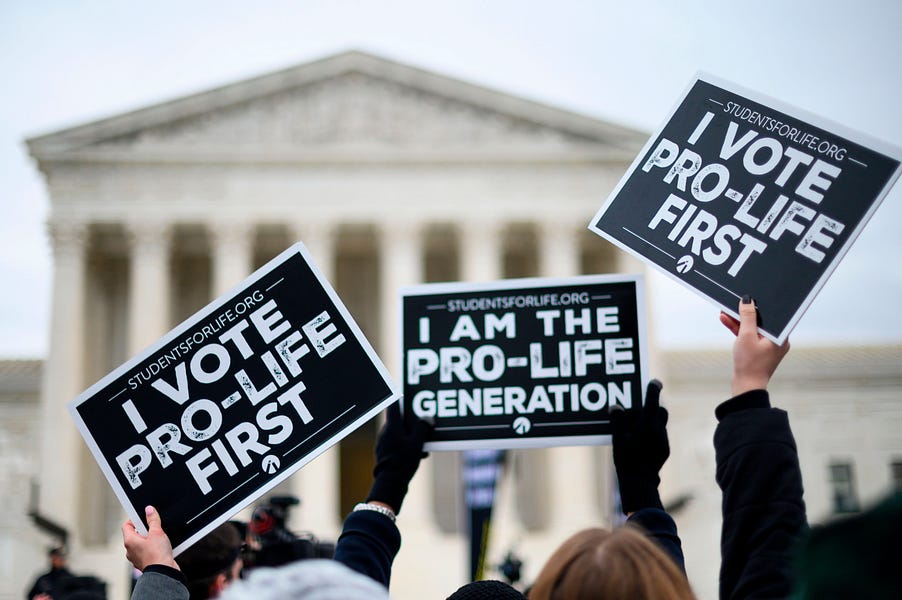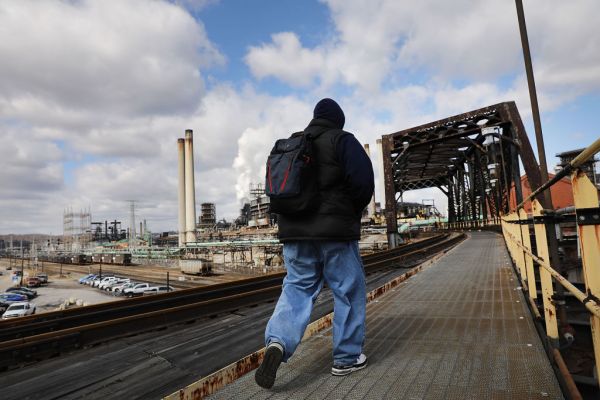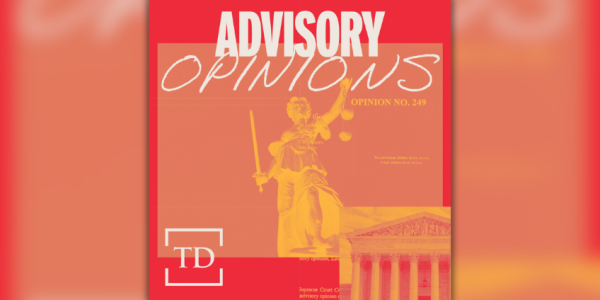For pro-life Americans, the annual March for Life is always a red-letter day. But for the tens of thousands who made their way to the National Mall Friday morning, this year’s gathering was particularly significant. President Donald Trump would be the first president to address the group in person. For many, the speech was a proof of Trump’s claim to be, as signs in the crowd put it, “the most pro-life president ever.”
But the president’s coming meant extra logistical hurdles to surmount: a line of metal detectors through which the rally-goers trickled slowly while the crowd grew larger outside. (Tardy but shrewd attendees could cheat a bit by working their way around to the Smithsonian Museum of Natural History, whose balcony offered a decent if distant view.)
So by the time the presidential motorcade rolled up shortly after noon, the March for Life was happening in split-screen: one crowd inside the gates, pressing toward the stage in eager anticipation, another milling outside, waiting to hear the speech through the loudspeakers, and yet another filling the surrounding streets, waiting for the march to start, unaware or unconcerned that any speech was happening at all.
It was a fitting illustration for a president and a movement whose relationship, three years into Trump’s first term, remains both enthusiastic and a bit murky. From the earliest days of his campaign, Trump has strained to convince pro-lifers he’s no longer the man who once called himself “pro-choice in every respect.”
As president, he has delivered in the form of a number of small but symbolically important policy changes: denying Title X family planning funds to abortion providers, reinstituting and expanding the “Mexico City policy” that forbids American tax dollars from funding abortions overseas, providing protections to religious organizations that ran afoul of President Obama’s contraception mandates. More importantly, he has stocked the federal judiciary with dozens of conservative judges, including two Supreme Court justices. Many pro-lifers agree he’s come through for them better than they could have hoped.
If you read some of the reports of the march, that’s about all there was to the story. From the Washington Post to the Daily Beast, the narrative was the same: The March for Life was a big, rowdy party for Trump and the masses who’ve agreed to overlook his every personal failing to to get the policy spoils he’s promised. “For Trump, the demonstration functioned as a built-in rally—a captive audience of some of his most fervent, unconditional supporters just a few blocks from his house,” Christina Cauterucci wrote inSlate. “It’s not hard to imagine why, in the middle of his impeachment trial, he’d want to spend a morning looking out on a beaming crowd of people in MAGA hats clutching posters with his face on them.”
But the story isn’t so tidy. Anyone who’s attended a Trump rally could tell you the mood among the marchers Friday was dramatically different. Wandering through the crowd, you’d hear the occasional spontaneous rally-ready chorus—“USA! USA”—but you’d be much likelier to encounter a group of Lutherans singing hymns or Catholics chanting the rosary. The crowd was dotted with “Trump 2020” hats, but far more common were the clusters of matching beanies identifying church or school groups that had trekked out for the march.
Reading between the lines, you could feel the same difference in Trump’s own speech. The bombast, the free-association rants, the self-indulgent cruelty—none of it was present here. The lines he did borrow from his stump speech, like a riff on the crowd size, served a subtly different purpose: Not bragging that they’d come to see him, but applauding that they’d come “to fight to raise the conscience of our nation and uphold the rights of our citizens.” The upshot was obvious: He’d come to them, not they to him.
Speaking to dozens of rally-goers over the course of the march, it slowly became clear why. Many, of course, were among Trump’s loyalists—Mike, who’d traveled from New Jersey with the Knights of Columbus and told me that “the swamp” doesn’t like the president because he’s “genuine, straightforward, and honest,” or James, who hailed from the archdiocese of New York and said that “he’s the one who’s fighting the hardest” against abortion in America.
Yet not a few of them, far from being Trump’s “most fervent, unconditional supporters,” were actually sober about the prospects of their movement and what Trump has to offer it. Concerns that the president makes a poor standard-bearer for an ethic of life, that he has failed to truly pull out all the stops to get a pro-life majority on the Supreme Court—these exist alongside genuine gratitude for the things he has done to aid the cause.
One of the first marchers I spoke to was Jonah, a youth group leader from Pittsburgh. One of the young women in the group had been gushing to me about the march: “I was honestly kind of scared at first, because I thought there were going to be people yelling at us, but people are very open with you. Everyone’s smiling.”
“I think it’s really important to remember that pro-life isn’t just about ending abortion, but it’s about helping people at every stage of their life,” Jonah told me. “Immigrant families, families at the border, taking care of them, taking a stance against euthanasia. … But the abortion issue, the unborn, they don’t have a voice. So the fact that he’s giving them a voice, for me, that’s huge.”
Judy, who’d made the three-day drive from Texas, praised Trump’s pro-life rhetoric while sounding a skeptical note that it came from the heart: “You know, everyone is pushing him as a pro-life president, everyone likes to think that he’s a pro-life president. So if he wants to accept that, I appreciate calling him that.”
Daniel, a student studying political science at Virginia’s Christendom College, described himself as a staunch Trump supporter, but said that he was skeptical that the president’s Supreme Court nominees could be trusted on life issues: “I’m not 100 percent optimistic about it. I don’t know how tough Kavanaugh would be on a pro-life stance. … But it’s a step in the right direction.”
Betty, an activist with Missouri Right to Life who’s been traveling to D.C. for the march for 30 years, said Trump had proved he was pro-life, but laughed aloud when I asked whether she had had apprehensions in 2016: “Amen! Yes! Terrible! The general feeling of the people that I knew, we really wondered what was going to happen with him. But we knew we didn’t want Hillary, we didn’t want the Democrats in there. Like some would say, you hold your nose and vote.”
In the eyes of these rally-goers Trump’s pro-life advances may have been modest, but the simple fact was that he has made pro-life advances—advances which, in their estimation, had certainly saved actual human lives.
These people weren’t delusional; they didn’t expect Trump to provide them a bolt from the blue to end abortion tomorrow, or this year, or this decade. Given the raw scale of abortion in America, how could they sustain their level of hope? What if—as another attendee, a self-described “pro-life Warren Democrat,” had insisted to me—Trump really had set the pro-life movement back 40 years? Even if not, didn’t the incredibly small triumphs Trump has provided just underscore how stacked the deck remains against the movement, even today?
I puzzled all these things over for more than half the march, unable to resolve the tension in my own mind. Then I saw a woman, not marching, but standing next to the marchers, waving an enormous “Evangelicals for Trump” flag. Her name was Diane Ventura. She told me that she had been a supporter of Trump’s since he came down the escalator.
“I do love our president. I support our president,” she said. “But one thing that is very bothering to me: So many people say, oh, it’s a landslide, we’re going to win, it’s already won. It’s not. It’s not. We have to vote. We can’t be lazy and say it’s going to be a landslide.”
She gestured out over the sea of marchers: “This is all great, but unless you go the polls, this is all nonsense. Waste of everyone’s time.”
What struck me then was precisely the absence of that sentiment from every marcher I’d talked to that day. I had encountered a wide range of opinions about how effective Trump had been or would be in advancing their cause—but not a single person suggesting that, if he did prove ineffective, their own efforts would have been in vain.
The story of right-wing politics in America over the last decade has been in many ways a story of collapse. The Tea Party dissolved in the growing unease of the second Obama term. Many convinced themselves that they’d simply been naïve, that concerning yourself overmuch with principles in politics was a suckers’ game.
The March for Life is devoid of such political calculation. The marchers are not strategists or triangulators; they are simply people who cannot bear that much of the country has agreed simply to look politely away from the terrible realities of abortion, and it has fallen to them to try to make looking away impossible. It’s a sentiment that will not go away no matter what political and legal setbacks the movement may suffer—there will always be more of them to proclaim it.
Photograph of activists at the March for Life by Roberto Schmidt//AFP via Getty Images.









Please note that we at The Dispatch hold ourselves, our work, and our commenters to a higher standard than other places on the internet. We welcome comments that foster genuine debate or discussion—including comments critical of us or our work—but responses that include ad hominem attacks on fellow Dispatch members or are intended to stoke fear and anger may be moderated.
You are currently using a limited time guest pass and do not have access to commenting. Consider subscribing to join the conversation.
With your membership, you only have the ability to comment on The Morning Dispatch articles. Consider upgrading to join the conversation everywhere.